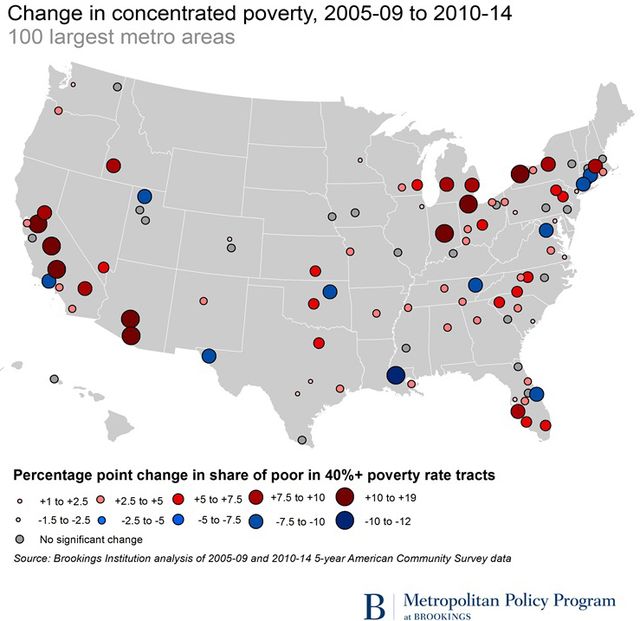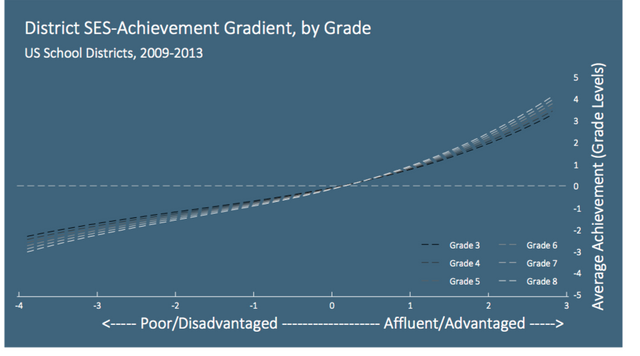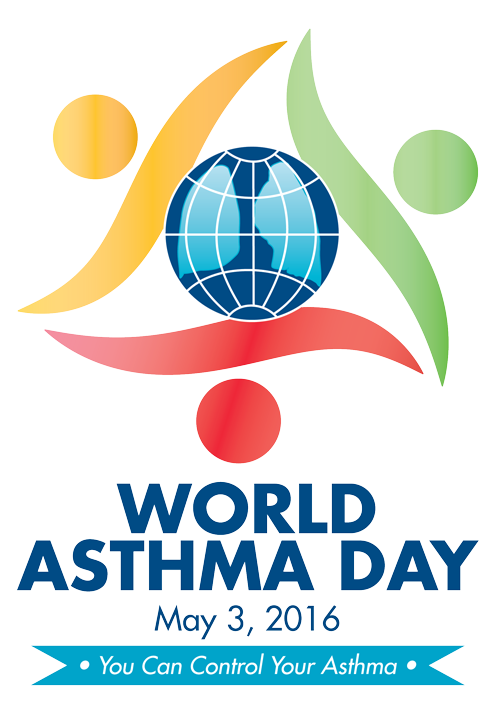Helen Hayes
On Friday, April 29, after spending his entire adult life at the notorious Louisiana State Penitentiary at Angola for a crime he did not commit, Gary Tyler, now 57 years old, walked out a free man.
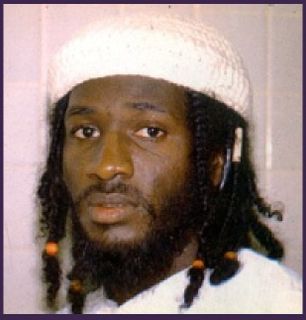 Gary Tyler in 1985
Gary Tyler in 1985
Tyler’s case is among the most brazen and brutal frame-ups in modern American history. His victimization exemplifies the violent and repressive character of class relations in the United States and the antidemocratic nature of the US “justice” system.
The Workers League and the Young Socialists, the forerunners of the Socialist Equality Party and the International Youth and Students for Social Equality, played the leading role in the campaign for Gary Tyler’s freedom. Our movement carried out a determined national and international struggle to mobilize the working class in his defense, insisting that his frame-up was fundamentally a class question and represented an attack on the working class as a whole.
In 1974, Tyler, then a 16-year-old student at Destrehan High School on the outskirts of New Orleans, was railroaded to prison for the October 7 shooting death of a 13-year-old white student, Timothy Weber. The killing occurred in a racially charged atmosphere whipped up by elements such as David Duke, then emerging as a leading figure in the Louisiana and national Ku Klux Klan—now a supporter of Republican presidential front-runner Donald Trump—in response to court-ordered busing to desegregate Destrehan and other high schools.
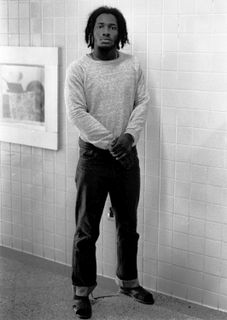 Gary Tyler in late 1977
Gary Tyler in late 1977
Tyler was among the group of African-American Destrehan students being sent home early that day due to tensions at the school. Weber was standing in a crowd of white students and adults shouting insults as the school bus pulled out, when a shot rang out, fatally wounding him. Tyler was arbitrarily singled out by sheriff’s deputies and taken to the local jail, where he was savagely beaten.
He was held in jail for a year, until he turned 17, so he could be tried as an adult. He was charged with first-degree murder, a charge that carried a mandatory sentence of death in the electric chair. His nine-day trial was a travesty. The alleged murder weapon—not found during initial searches—turned out to be a pistol that had “disappeared” from a police firing range. The gun later went missing. The trial judge, Ruche Marino, was reportedly a member of the White Citizens Council.
The only “evidence” against Tyler was testimony from students, black and white, who subsequently recanted their statements at trial, in some cases charging that they had been terrorized and threatened by police to make them falsely incriminate Tyler.
Convicted by an all-white jury, Tyler was initially sentenced to be executed on May 1, 1976, almost exactly 40 years prior to the date of his eventual release. He spent two years on death row at Angola prison, becoming at the time the youngest death row inmate in the US. The death sentence was commuted to life imprisonment without the possibility of parole only after the US Supreme Court ruled, in 1977, that the Louisiana death penalty statute was unconstitutional. The authorities vindictively kept the young man in solitary confinement for eight years.
They refused to release Tyler or grant him a new trial despite a 1980 ruling by the Fifth Circuit of the US Court of Appeals that his trial was unconstitutional and “fundamentally unfair.” Instead, the attorneys general of Louisiana, Texas and Florida petitioned the Fifth Circuit Court to change its decision. They feared that giving Gary a new trial would derail scores of similar frame-ups throughout the south. In 1981, the appeals court overturned its own ruling on a legal technicality.
Tyler’s attorneys appealed this ruling to the Supreme Court, which refused to hear the case.
Both big-business parties are complicit in the frame-up and decades-long imprisonment of Tyler. The teenager was railroaded to prison under Republican President Gerald Ford and the state administration of Louisiana Governor Edwin Edwards, a Democrat. He was kept in jail by Democratic Governor Charles “Buddy” Roemer despite three separate recommendations from the Louisiana state parole board that his sentence be reduced, which would have allowed him to go free many years ago.
In 1994, Amnesty International declared Gary Tyler to be a political prisoner. In 2008, Democratic Governor Kathleen Blanco left office without acting on new calls for Tyler’s release from prominent journalists and cultural figures.
The state of Louisiana finally allowed Tyler to go free only after a series of rulings by the US Supreme Court left it with no alternative. In 2013, Tyler’s lawyer filed a motion on the basis of the 2012 decision in Miller v. Alabama in which the court said mandatory life sentences without the possibility of parole for juvenile offenders violated the US Constitution. Earlier this year, in Montgomery v. Louisiana, the high court held that its decision in Miller had to be applied retroactively.
Even so, the state authorities insisted that in return for his freedom, Tyler, who had always maintained his innocence, accept a plea deal in which he pled guilty to manslaughter. Last Friday, a state judge accepted Tyler’s plea and sentenced him to the maximum 21-year term for manslaughter, far less time than he had already served.
Tyler, having lost both parents and a number of siblings while in prison, was able to leave prison for the first time since he was arrested at the age of 16.
The arrest, frame-up and conviction of Tyler took place in the context of a mounting economic and political crisis of American capitalism. The shooting at Destrehan High School occurred only weeks after the resignation of Richard Nixon as a result of the Watergate revelations, the first ever resignation of a sitting US president.
On the international front, the US was heading for an ignominious defeat in Vietnam.
Political hatred for Nixon was accompanied by militant struggles by coal miners, autoworkers, teachers, public employees and other sections of workers against the initial attempts of the American ruling class to impose the cost of its economic decline on the working class. Under Nixon’s successor, Gerald Ford, the US entered into the deepest recession to that point since the end of World War II, which continued under the Democratic Carter administration.
The stage was set for the ruling class, under Ronald Reagan, to launch a counteroffensive against the working class, targeting all of its past social gains and its democratic rights—a class-war policy that has continued unabated ever since. The trade unions enabled this offensive to proceed by betraying every struggle of the working class against mass layoffs, plant closures, wage cuts and union-busting, beginning with their de facto alliance with the Reagan administration against the PATCO air traffic controllers in 1981.
When the Workers League and Young Socialists learned of Tyler’s frame-up and looming execution in 1976, our movement organized a powerful and sustained campaign to mobilize support in the working class for his freedom. We recognized that this was part of an attack on the entire working class, and that Tyler’s freedom could be won only by mobilizing workers independently of and in opposition to the capitalist two-party system.
The Young Socialists issued a pamphlet titled The Frameup of Gary Tylerthat sold tens of thousands of copies and went through three editions. The pamphlet outlined the basic facts in the case, explained that this was an attack on the working class as a whole, and called for the unity of black and white workers to fight for Tyler’s freedom.
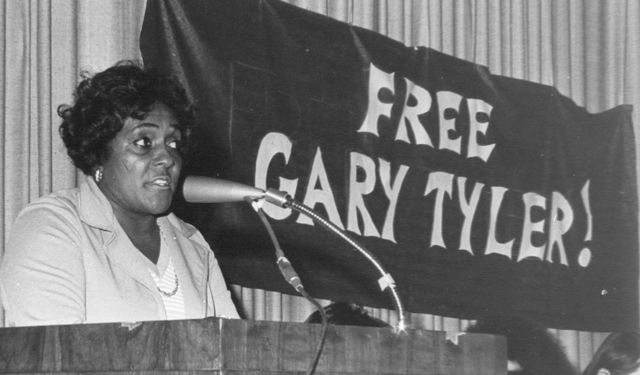 Juanita Tyler speaking at a Young Socialist conference in Detroit, 1976
Juanita Tyler speaking at a Young Socialist conference in Detroit, 1976
The pamphlet stated in its introduction that the freedom of Tyler and other political prisoners could not be secured “through protests and appeals to the government and its courts.” It continued: “These are the forces that carried out these frame-ups as part of their preparations for the most savage attacks on the basic rights of all workers and youth. Defending Gary Tyler means fighting to rouse the strength of the working class against Jimmy Carter and the capitalist system which is responsible for these attacks.”
Within the space of a few months, 40,000 signatures were collected on petitions and the support of union bodies representing hundreds of thousands of workers was secured in the fight for Gary’s defense. Our movement carried out this struggle internationally, and the appeal for Tyler’s freedom began to draw widespread attention, with songs written and performed by Gil Scott Heron and UB 40, among others.
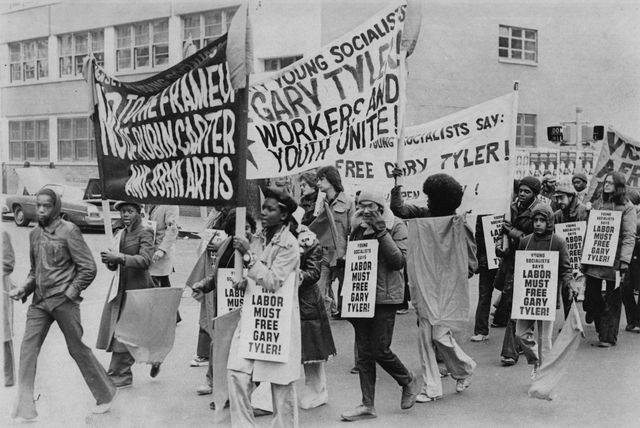 The Young Socialist march to free Gary Tyler in Harlem, December 1976
The Young Socialist march to free Gary Tyler in Harlem, December 1976
On December 4, 1976, the Young Socialists organized a powerful march and rally in Harlem, New York that was joined by hundreds of young people and workers, including autoworkers, transit workers, teachers and striking newspaper pressmen, to demand Tyler’s freedom and review the political implications of his frame-up.
Tyler sent a message to the demonstrators from prison, which read, in part: “While here in a state of incarceration, I have decided to write this statement. I really appreciate the things you all are doing to help me to obtain justice that the government says truly exists within this country. But, how could justice exist when Democracy only applies for the rich and not for the working class and especially not for the poor?... Democracy for an insignificant minority, democracy for the rich—that is the democracy of capitalist society.”
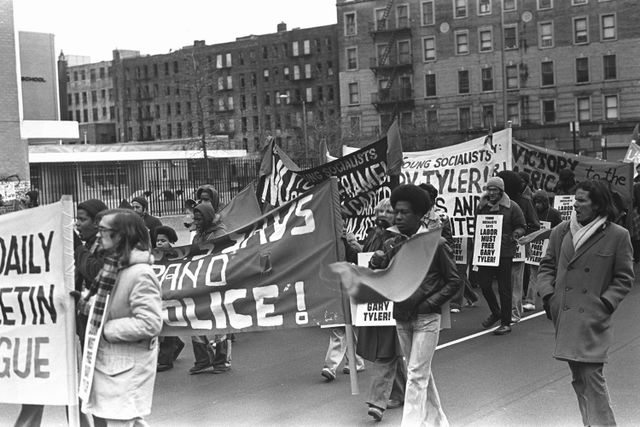 Tom Henehan (right) leading the 1976 march in Harlem
Tom Henehan (right) leading the 1976 march in Harlem
In 1977, Tom Henehan, a leading member of the Workers League, was killed in a political assassination at a Young Socialists social held in Brooklyn to raise funds for the defense of Tyler. In 1985, we published a pamphlet featuring an interview with Tyler obtained by Young Socialists National Secretary D’Artagnan Collier, who visited the 27-year-old prisoner at Angola state penitentiary.
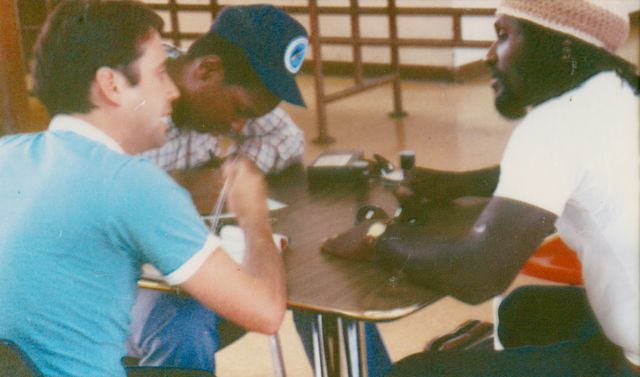 Young Socialists interview Gary Tyler in Angola State Penitentiary July 10, 1985
Young Socialists interview Gary Tyler in Angola State Penitentiary July 10, 1985
The Socialist Equality Party, the IYSSE and the World Socialist Web Site continued to bring Tyler’s case to the attention of a national and international audience, despite a virtual blackout in the media. In 2012, SEP members held a meeting in New Orleans as part of the presidential campaign of Jerry White in that year’s national elections and raised the demand for Tyler’s freedom. They met with Tyler’s mother, Juanita Tyler, shortly before her death at the age of 80.
Gary Tyler’s conviction and the time he spent in prison expose the brutal class character of the American judicial system and its vast prison complex. Since his frame-up, the assault on the living standards and democratic rights of the working class has intensified. It has been stepped up under the cover of the fraudulent “war on terror” and especially since the Wall Street crash of 2008. Under the Obama administration, it has reached new heights, with the expansion of war, a record growth of social inequality, and an escalation of government surveillance and the militarization of the police.
Today, the issues raised by our movement in the fight for Gary Tyler’s freedom—the inseparable connection between the defense of democratic rights and the fight for socialism—retain their full urgency.
